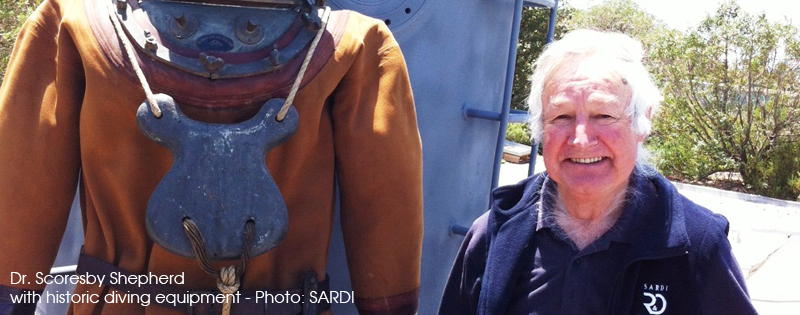Originally published in Southern Fisheries magazine – Spring 2000
Dr Scoresby Shepherd’s fascination with marine life was fired by the exploits of legendary French diver and adventurer, Jacques-Yves Cousteau. It was in the 1950s and Scoresby was a young man, working towards a career in law. Between studies, he helped form an underwater research group, diving with homemade equipment to collect marine specimens for museums.
By the early 1960s, Scoresby had become a successful lawyer. However, he had immersed himself in water as much as he had in books and his preoccupation with diving made him something of a local authority on everything under the waves.
Between 1963 and 1968, he was seconded on a voluntary basis to assist in a geological survey of Gulf St. Vincent and after more than 500 dives, he helped produce a detailed map of life on the sea floor. This map remains the only one of its kind and it is still used today as a reference to the submarine landscape in our gulf.
The success of the survey and his expertise in identifying marine species attracted the interest of the then Director of Fisheries, Mick Olsen, who invited him to join what was then known as the Department of Fisheries and Fauna Conservation. Scoresby did not need to be asked twice, and he became the department’s first expert on the biology of marine species, initially with the challenge of helping lay the foundation of a sustainable abalone fishery.
At the time there were 110 abalone licenses in South Australia, a figure which over the years has been culled to 35.
Scoresby’s work involved researching the growth and reproductive patterns, leading to size limits being established, and the introduction in the mid-1980s of quotas.
His research on the fishing of wild abalone populations included pioneering work on aging the fish by reading the rings or layers produced each year on the shell. This provided valuable insight into the mortality rate of abalone, with key pointers to the intensity of fishing.
Soon, Scoresby identified threats to abalone populations, particularly off the west coast of the state.
His reputation in abalone biology attracted the interest of overseas fisheries authorities, taking him on research expeditions to Mexico, Oman, Alaska, Canada and Japan. Diving on the vast kelp forests and huge populations of sea urchins off Alaska was a particular highlight.
In 1992, Abalone of the World, eidted by Scoresby Shepherd was published as a global reference book on one of the world’s most sought after, yet threatened marine delicacies.
But Scoresby’s research was not confined to abalone.
In 1971, he wrote the legislation which became the Fisheries Act, paving the way for marine parks in South Australia.
His broad experience with marine life led to editing of the acclaimed volumes Marine Invertebrates of South Australia, which has become an ongoing task as scientists learn more about the biodiversity and unique qualities of South Australia’s marine habitats.
“My intention in publishing these volumes was to enhance understanding of marine systems so that we may achieve ecologically sustainable fisheries,” Scoresby said.
“My work has always been directed at helping maintain marine habitats for the enjoyment of future generations. I want people to share the same sense of wonder that I experienced when I first started diving as a boy.”
In August, after almost 40 years in marine research, Scoresby, 65, retired from his senior role at SARDI Aquatic Sciences. For almost half of his life, Scoresby managed to spend 50 days at sea each year, spending at least 3 hours each day under the water in pursuit of knowledge. What started as a hobby became a career and an enduring passion.
“I remained concerned about the future of the abalone fishery, particularly in inshore areas of the west coast,” he said. “We have built data and scientific knowledge, but the industry itself has no collective memory of the way things used to be. because of this limited collective memory, there is a shifting baseline among fishers which may only date back five or ten years.”
“We have catch information dating back to 1971, and it will require a commitment by the industry to the restoration of the fisheries in some areas. We have already started transferring abalone from inshore areas to deeper water in Avoid Bay, Anxious Bay and Farm Beach.”
Scoresby has gained enormous satisfaction in working with biologists at a national and international level, recognising that local concerns are also global ecological problems and challenges. Despite his retirement, he is not about to go into “dry dock”.
Rather, Scoresby and his wife Anna, a linguist, are about to leave for a year of voluntary work with the internationally funded Charles Darwin Station in the Galapagos Islands, off the north-west coast of South America.
This network of islands, with their unique and individual ecosystems are often referred to as the crucible of evolution, an environment which Scoresby will relish.
After his year’s work in the Galapagos Islands, Scoresby plans to return to Adelaide to write another book on abalone and update the volumes on marine invertebrates in our waters.
He reflects with great satisfaction on his years in marine biology, and his career of interaction with other researchers locally, interstate and around the world.
“One of the great challenges of marine science is to focus on the marine environment as a whole, rather than single species management,” he said.
“It was Einstein who said science without ethics is bankrupt. The ethical framework of marine research must focus on ecological sustainability.”

